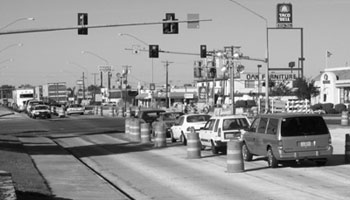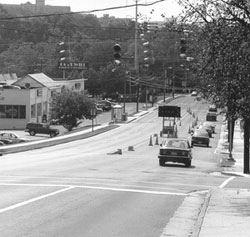U.S. Department of Transportation
Federal Highway Administration
1200 New Jersey Avenue, SE
Washington, DC 20590
202-366-4000
Focus
| Accelerating Infrastructure Innovations |
Publication Number: FHWA-RD-03-020
Date: August 2003
Maintaining and preserving the Nation's aging highway system means that motorists increasingly encounter work zones as part of daily travel. At the same time, traffic volumes and congestion continue to grow. From 1980 to 2000, total vehicle miles traveled in the United States increased 80 percent, while total lane miles of public roads increased by only 2.4 percent. The combination of heavier traffic volumes occurring on road networks with more work zones increases the impacts of those work zones on both congestion and safety. In 2001, 1,079 persons were killed in work zone-related crashes and more than 40,000 were injured. To address these heightened impacts, the Federal Highway Administration (FHWA) is developing a final rule on work zone safety and mobility to update the National Work Zone Safety Program established in 1995.
 |
| FHWA's new proposed regulations address both the safety and mobility of the Nation's work zones. |
 |
An Advance Notice of Proposed Rulemaking was submitted to the Federal Register on February 6, 2002. After analyzing the comments received, FHWA submitted a Notice of Proposed Rulemaking (NPRM) on May 7, 2003. The NPRM can be found on the Web at www.regulations.gov/freddocs/03-11020.htm. Comments on the proposed rule are due September 4, 2003, with publication of the final rule expected by spring 2004. Comments can be submitted to http://dms.dot.gov/submit/.
"The regulations address both safety and mobility, recognizing the impact of work zones on both," says Scott Battles, Work Zone Mobility and Safety Team Leader at FHWA. The proposed changes include: Work Zone Mobility and Safety Policy -States are required to develop and adopt a policy that supports the consideration of the mobility and safety impacts of roadwork accomplished with Federal-aid highway funding. These impacts should be considered both early in the project planning and through the later stages of project development. The content of the policy would be determined by the State. Examples of topics that could be addressed include classifying road projects into different types based on the expected severity of work zone impacts and developing alternative project planning and design strategies to minimize the impact of work zones on highway users. The policy could also set work zone performance standards. For example, the Ohio Department of Transportation has adopted a policy that sets limitations on the number of lanes that may be closed for construction activities on freeways and similar highways.
Work Zone Impacts Analysis- Agencies would be required to perform a work zone impact analysis for Federal-aid highway projects. However, the degree of analysis is scaleable, based upon agency policy and the expected level of impacts due to specific project characteristics. The impact analysis will facilitate the consideration of alternative project options and work zone mitigation measures, such as closing roads completely for rehabilitation work, performing work during night-time and off-peak hours, choosing longer-lasting materials to cut down on the need for future maintenance, or accelerating the construction process.
Transportation Management Plans (TMP) -While TMPs are required for all Federal-aid projects, the extent of the TMP depends upon the results of the work zone impact analysis. At a minimum, a traffic control plan is required for all projects, which is no change from the current regulations. Under the new regulations, a transportation operations plan is also required if recommended by the impact analysis study. This plan should include methods of managing work zone traffic operations, such as through use of intelligent transportation system traffic control and traveler information technology, speed management and enforcement measures, and safety reviews and audits. Going a step further, a public information and outreach plan should be developed if the impact analysis recommends it. The plan should cover methods for ensuring that affected road users, the general public, businesses, and other appropriate entities are informed about the project, the expected work impacts, and the changing conditions of the project.
For more information on the proposed regulations, contact Scott Battles at FHWA, 202-366-4372 (email: scott.battles@fhwa.dot.gov).